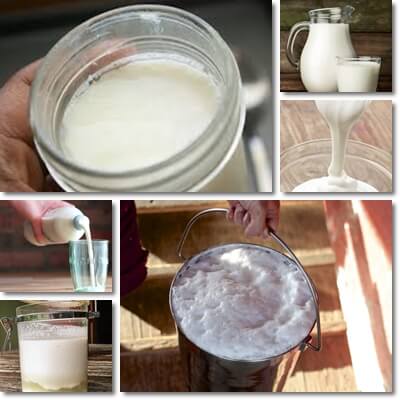Buttermilk is a healthy, naturally fermented milk obtained as a by-product of butter-making. There is only one real buttermilk, which is the leftover milk following extraction of butter from fermented whole milk or cream. Several cultured milk and acidified milk products are also called buttermilk, but are really just substitutes. The difference between real buttermilk and its substitutes is that real buttermilk is a sour, naturally-fermented, skim milk product, whereas the substitutes are either whole fat or reduced fat, creamier (because of the presence of varying amounts of milk fat) and made from previously pasteurized milk to which selected bacteria cultures are added following the heat treatment, then allowed to ferment. Some countries don’t have real buttermilk, only the substitutes which are known by the same name. The main types of buttermilk and substitutes and how they are made:
1) Traditional buttermilk
Variants exist throughout the continents and involve the use of a manual churn to vigorously agitate naturally fermented whole milk or cream (the fat from unprocessed milk that rises to the surface). The fat would rise to the surface and be collected with a wooden spoon into a bowl, while the remaining liquid, called buttermilk, would remain in the churn. Because it was not a very exact method, not all fat could be extracted from the first churning process. My grandmother used to add several glasses of cold water to the remaining buttermilk and continue to churn it until the last, scattered droplets of milk fat would clump together so they could be collected as well. The resulting buttermilk was a sour, acidic, low-fat milk product. Read more on the Properties and Benefits of Buttermilk.

2) Commercial buttermilk
Due to modern food safety regulations, whole or reduced fat milk is first pasteurized (thermically prepared to eliminate existing microorganisms, prevent fermentation and spoilage) and sometimes also homogenized (mixed at high pressure so that the liquid part and the fat in milk mix together almost indistinguishably, resulting in a creamier and apparently reduced-fat milk). Because pasteurization eliminates naturally occurring bacteria, selected bacteria cultures are added to the pasteurized milk and then allowed to ferment. The resulting product is labeled buttermilk, although it technically isn’t. Because some or all of the fat in the milk is kept (not collected for butter making), commercial buttermilk is usually thicker and creamier than traditional buttermilk.
Because of the addition of selected bacteria cultures, most commercial buttermilk is also known as cultured buttermilk, although it’s really just a fermented milk product, not real buttermilk. Alternatively, it’s called buttermilk substitute. Traditional buttermilk can also be considered a type of cultured buttermilk because it’s made from naturally fermented (raw, whole) milk. Overall, the commercial, cultured milk product is a healthy dairy drink with similar benefits to its traditional counterpart thanks to the presence of selected bacteria cultures which provide excellent probiotic properties.
3) Acidified buttermilk
It refers to buttermilk-like products obtained through addition of edible natural food acids. Vinegar (which contains acetic acid and smaller amounts of citric and malic acid too in some varieties), lemon and lime juice (which contain citric acid) are commonly added to whole or reduced fat milk. The acidic element causes the pH of the milk to change which results in the free-floating proteins in the milk to clump together. The remaining liquid is often known as acidified buttermilk, but is not real buttermilk. It’s more like a soured milk or buttermilk substitute. Read more about the Properties and Benefits of Soured Milk.

How to make traditional buttermilk at home
Well, you’d need raw (so fresh or sweet and unpasteurized) whole milk. You need to leave it in a cool place to ferment (but not refrigerated, so natural fermentation can still take place); this could take anywhere from several hours to 1-2 days (so check it regularly). When the milk is soured and thickened a little (but not spoilt), you churn it. You can use a hand butter churn device for this or a smaller version of an old-fashioned butter churn, if you have them and are looking to recreate the original experience. A modern food mixer is even better as it’s something everyone has, is automatized and requires far less time and effort. You just add the fermented milk to a bowl and mix.
With a standard food mixer, it may take anywhere from 5 minutes to 10-15 minutes for the fat to separate into butter. The butter will clump together, while the leftover milk in the bowl is the buttermilk. Because the milk was initially fermented, the buttermilk should taste sour. Even easier, use sour cream (the more fat it contains, the better), mix it with a food mixer and you’ll get both butter and buttermilk. The equivalent of sour cream in other countries is creme fraiche in France, smetana in Central and Eastern Europe, smântână in Romania etc., preferably over 35% to 45% butterfat content and partially or fully fermented. Check your sour cream to make sure it doesn’t contains additives like thickening agents (the best products should contain butterfat and lactic acid bacteria cultures only).
How to make sweet buttermilk at home
The simplest method to make sweet buttermilk at home is to get cream or sweet cream (not sour cream, not fermented cream if you want to make sweet buttermilk). Put the cream in a food processor, then mix it at slow speed for 2-4 minutes and an additional 2-4 minutes at high speed, if needed. The fat should clump together and separate from the liquid. The fat is the butter and the remaining liquid is the sweet buttermilk. It may not be the same thing as traditional buttermilk, but it’s still a low-fat milk product.
How to make cultured buttermilk at home
You can make a buttermilk substitute by heating raw, whole milk until it’s barely warm (to stimulate bacterial fermentation). Then add about two tablespoons of sour yogurt (containing lactic acid bacteria) and mix well. The lactic acid bacteria in the sour yogurt will act as a starter culture and ferment the milk. Leave at room temperature to ferment (this step may take anywhere from 24 hours to 2-3 days, so check it regularly so it doesn’t spoil). Check if the milk has curdled (thickened) and become sour in taste. When it has, the buttermilk is ready. At this point, it should be refrigerated to prevent spoilage. Although not traditional buttermilk, it’s still a healthy dairy with yogurt-like probiotic properties and no additives.
How to make (acidified) buttermilk substitute for cooking
Add one tablespoon of lemon juice, lime juice or white vinegar to one cup of fresh or raw, preferably whole milk and mix well. Under the action of the natural food acids, the milk proteins should start to curdle, resulting in a buttermilk substitute called acidified buttermilk. It should take around 10-15 minutes. While the taste of the lemon juice or vinegar or whatever you may use should not be observed in the milk, this substitute is best suited for cooking, especially baking. The acidity of the milk reacts with baking soda, resulting in a great leavening agent. The lactic acid in traditional and cultured buttermilk also acts as a leavening agent, which is why both can be used for baking and produce beautiful rising in dough.
Considering the most common resources in any given household, these are essentially the best ways to make buttermilk and buttermilk substitutes at home with the least effort and using the simplest recipes. And since practice makes perfect, don’t be disappointed if it doesn’t turn out great the first time and don’t be afraid to adjust the recipe or ingredients to your liking. Also, any tips and advice from all of you who enjoy making your own fermented milk and dairy products are greatly appreciated.
